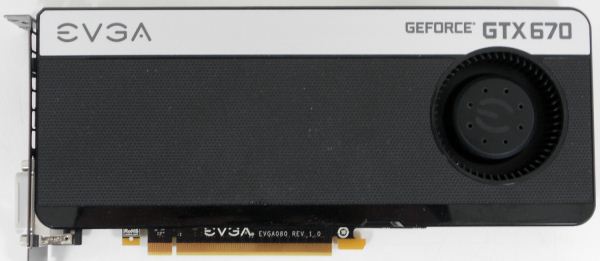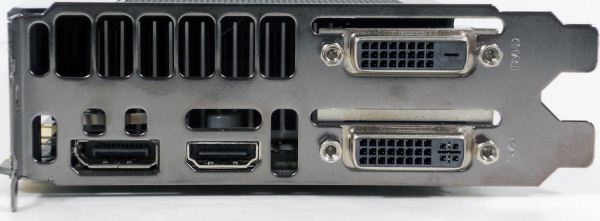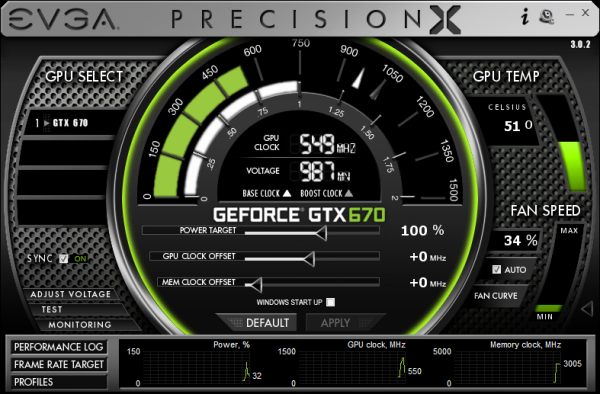NVIDIA GeForce GTX 670 Review Feat. EVGA: Bringing GK104 Down To $400
by Ryan Smith on May 10, 2012 9:00 AM ESTMeet The EVGA GeForce GTX 670 Superclocked
Our second card of the day is EVGA’s GeForce GTX 670 Superclocked, which in EVGA’s hierarchy is their first tier of factory overclocked cards. EVGA is binning GTX 670s and in turn promoting some of them to this tier, which means the GTX 670 Superclocked are equipped with generally better performing chips than the average reference card.
| GeForce GTX 670 Partner Card Specification Comparison | ||||
| EVGA GeForce GTX 670 Superclocked | GeForce GTX 670 (Ref) | |||
| CUDA Cores | 1344 | 1344 | ||
| Texture Units | 112 | 112 | ||
| ROPs | 32 | 32 | ||
| Base Clock | 967MHz | 915MHz | ||
| Boost Clock | 1046MHz | 980MHz | ||
| Memory Clock | 6210MHz | 6008MHz | ||
| Memory Bus Width | 256-bit | 256-bit | ||
| Frame Buffer | 2GB | 2GB | ||
| TDP | 170W | 170W | ||
| Manufacturing Process | TSMC 28nm | TSMC 28nm | ||
| Width | Double Slot | Double Slot | ||
| Length | 9.5" | 9.5" | ||
| Warranty | 3 Years | N/A | ||
| Price Point | $419 | $399 | ||
For the GTX 670 SC, EVGA has given both the core clock and memory clock a moderate boost. The core clock has been increased by 52MHz (6%) to 967MHz base and 66MHz (7%) boost to 1046MHz. Meanwhile the memory clock has been increased by 202MHz (3%) to 6210MHz.
Other than the clockspeed changes, the GTX 670 SC is an almost-reference card utilizing a reference PCB with a slightly modified cooler. EVGA is fabricating their own shroud, but they’ve copied NVIDIA’s reference shroud down to almost the last detail. The only functional difference is that the diameter of the fan intake is about 5mm less, otherwise the only difference is that EVGA has detailed it differently than NVIDIA and used some rounded corners in place of square corners.
The only other change you’ll notice is that EVGA is using their own high flow bracket in place of NVIDIA’s bracket. The high flow bracket cuts away as much metal as possible, maximizing the area of the vents. Though based on our power and temperature readings, this doesn’t seem to have notably impacted the GTX 670 SC.
While we’re on the matter of customized cards and factory overclocks, it’s worth reiterating NVIDIA’s position on factory overclocked cards. Reference and semi-custom cards (that is, cards using the reference PCB) must adhere to NVIDIA’s power target limits. For GTX 670 this is a 141W power target, with a maximum power target of 122% (170W). Fully custom cards with better power delivery circuitry can go higher, but not semi-custom cards. As a result the flexibility in building semi-custom cards comes down to binning. EVGA can bin better chips and use them in cards such as the Superclocked – such as our sample which can go 17 boost bins over the base clock versus 13 bins for our reference GTX 670 – but at the end of the day for stock performance they’re at the mercy of what can be accomplished within 141W/170W.
In any case, as the card is otherwise a reference GTX 670 EVGA is relying on the combination of their factory overclock, their toolset, and their strong reputation for support to carry the card. EVGA has priced the card at $419, $20 over the GTX 670 MSRP, in-line with other factory overclocked cards.
On the subject of pricing and warranties, since this is the first EVGA card we’ve reviewed since April 1st, this is a good time to go over the recent warranty changes EVGA has made.
Starting April 1st, EVGA has implemented what they’re calling their new Global Warranty Policy. Starting July 1st, 2011 (the policy is being backdated), all new EVGA cards ship with at least a 3 year warranty. And for the GTX 600 series specifically, so far EVGA has only offered models with a 3 year warranty in North America, which simplifies their product lineup.
To complement the 3 year warranty and replace the lack of longer term warranties, EVGA is now directly selling 2 and 7 year warranty extensions, for a total of 5 and 10 years respectively. So instead of buying a card with a 3 year warranty or a longer warranty, you’ll simply buy the 3 year card and then buy a warranty extension to go with it. However the extended warranty requires that the card be registered and the warranty purchased within 30 days.
The second change is that the base 3 year warranty no longer requires product registration. EVGA has other ways to entice buyers into registering, but they’ll now honor all applicable cards for 3 years regardless of the registration status. At the same time the base 3 year warranty is now a per-product warranty (e.g. a transferable warranty) rather than per-user warranty, so the base warranty will transfer to 2nd hand buyers. The extended warranties however will not.
The third change is how EVGA is actually going to handle the warranty process. First and foremost, EVGA is now allowing cards to be sent to the nearest EVGA RMA office rather than the office for the region the card was purchased from. For example a buyer moving from Europe to North America can send the card to EVGA’s North American offices rather than sending it overseas.
Finally, EVGA is now doing free cross shipping, alongside their existing Advanced RMA program. EVGA will now cross-ship replacement cards for free to buyers. The buyer meanwhile is responsible for paying to ship the faulty card back and putting up collateral on the new card until EVGA receives the old card.
There’s also one quick change to the step-up program that will impact some customers. With the move to purchasing extended warranties, the step-up program is only available to customers who either purchase an extended warranty or purchase an older generation card that comes with a lifetime warranty. Step-up is not available to cards with only the base 3 year warranty.
Moving on, along with EVGA’s new warranty EVGA is bundling the latest version of their GPU utilities, Precision X and OC Scanner X.
Precision X, as we touched upon quickly in our GTX 680 review, is the latest iteration of EVGA’s Precision overclocking & monitoring utility. It’s still based on RivaTuner and along with adding support for the GTX 600 series features (power targets, framerate caps, etc), it also introduces a new UI. Functionality wise it’s still at the top of the pack along with the similarly RivaTuner powered MSI Afterburner. Personally I’m not a fan of the new UI – circular UIs and sliders aren’t particularly easy to read – but it gets the job done.
OC Scanner X has also received a facelift and functionality upgrade of its own. Along with its basic FurMark-ish stress testing and error checking, it now also offers a basic CPU stress test and GPU benchmark.



















414 Comments
View All Comments
Pantsu - Saturday, May 12, 2012 - link
So you completely ignored the truth about the price difference, and could not even understand the review.You can continue believing that Nvidia drivers are perfect and if there's a problem, it's obviously not Nvidia's. Meanwhile I keep on playing Shogun II. :)
CeriseCogburn - Saturday, May 12, 2012 - link
Yes, whatever, the 7970 has fallen to where it belongs, $100 less than the 680 - I haven't ignored that, I said go buy your fallen junk, but just don't spew out your lies about OC superior not ready to back it up.Go get the loser card, no problem- just stop telling me it's better when it crashed to dingbat bin price as soon as the 680 stood up. There is a reason for that, one you refuse to acknowledge. You people obviously believe the laws of the market do not apply, and often stretch scientific reality to the outer realms as well.
Let us know if you have half your games fail if you ever do buy a card, which it appears by all the talk and no action yet, you are not going to anyway, so it's been fun watching the endless spinning from you nonetheless.
raghu78 - Thursday, May 10, 2012 - link
RyanIncluding a 670 OC in your benchmarks while not including HD 7950 OC when you have so many HD 7950 OC cards available in the market is not an objective and fair comparison. Given that HD 7950 OC editions are available at USD 399 those should have been included. HD 7950 scales beautifully with higher clock speeds. In your overclocking section there should be HD 7950 OC edition benchmarked at overclocks using AMD CCC. HD 7950 OC cards regularly hit 1050 Mhz in AMD CCC. I am confident the HD 7950 OC at 1050 Mhz will give the GTX 670 OC overclocked a run for its money.
The fact that HD 7970s have been available from launch day at 1 Ghz speeds like XFX HD 7970 DD Black edition and that recently cards like MSI HD 7970 Lightning (1070 Mhz) and Powercolor PCS+ HD 7970 Vortex II (1100 Mhz) too have been available should be considered. The least you can do is include the 7970 OC cards and 680 OC cards to give a clear idea of the potential of these GPUs.After 4 months from HD 7970 launch I am yet to see a single HD 7970 OC edition review other than the XFX HD 7970 DD Black edition which was done on Jan 9, 2012.
I can't speak for anyone but frankly it seems that there is bias towards Nvidia. In my opinion the HD 7970 and HD 7950 are good products and superior than GTX 680 / GTX 670 given its focus on gaming and compute. Also the Tahiti chip performance scales beautifully with OC and it has great OC headroom. I expected anandtech to do a better job at making a really fair and objective comparison.
Ryan Smith - Thursday, May 10, 2012 - link
Hi raghu;As a matter of policy we only include the OC results for the card(s) being reviewed in the article. The purpose of our OC testing is not to determine what overclocked card is faster, but rather to give you an idea of how far we could overclock the card being reviewed and what kind of performance it can achieve.
We do not review overclocked cards in the manner you suggest because that's one lucky/unlucky card away from having significantly different results (just look at our memory overclocks). GPU overclocking is unreliable and should be considered a nice extra at best; it should not be used as the basis to choose between different GPUs.
-Thanks
Ryan Smith
raghu78 - Thursday, May 10, 2012 - link
The least anandtech can do is have separate HD 7950 OC vs GTX 670 OC cards and 680 OC vs HD 7970 OC cards head to head comparison reviews.The fastest OC models in the market for both cards can be choosen and benched both at stock and overclocked. Such reviews would give a clear idea of the potential of the GPUs.
RussianSensation - Thursday, May 10, 2012 - link
Look at the benchmarks where GTX670 OC wins. The lead is so dramatic, even if you overclock HD7950 by 40-50%, it still won't win. And that's assuming perfect 40% scaling with a 40% overclock which won't happen on the 7950.Of course hardly anyone would buy a card for the same price that requires overclocking lottery of 50% just to match a reference overclocked 670, not to mention the 7950 would consume 100W+ more power in the process. 7950 is no longer relevant at $399. It needs to drop to $349 at most. Also, some $420-430 after market 670s already hit 1300-1400mhz in GPU Boost which would easily go head to head with a 1250mhz 7970. HD7950 has no chance.
raghu78 - Thursday, May 10, 2012 - link
I look at the most demanding games at maximum image quality settings which are doing less than 60+ fps at 2560 x 1600 cause those are the games that really stress the GPU . BF3 , Alan Wake, Crysis 2, The Witcher 2, Total War Shogun 2, Anno 2070, Batman Arkham City fall in that list. Above 60 fps its not going to make a difference unless you are in a multiplayer competition. A HD 7970 at 1250 Mhz will beat or tie a 680 OC at 1350 Mhz in each of these games. Wanna betMorg. - Thursday, May 10, 2012 - link
I'll bet on that lightning ;) - but tbqh IT would help to see a benchmark of more recent tahiti dies, yields have far improved since release after all.JlHADJOE - Thursday, May 10, 2012 - link
HH benchies say they're just about even at 5760x1080 (6.2Mp), even when the AMD card has the higher clocks. Nvidia won every test at the lower resolution of 1080p (2.1Mp). It's a bit hard to infer performance at 1600p (4Mp) but I'm guessing they should be nearly even.MSI Lightning 7970 @ 1265
ASUS Reference 680 @ 1218 Boost
http://www.hardwareheaven.com/reviews/1455/pg6/asu...
CeriseCogburn - Friday, May 11, 2012 - link
Yes, how much are we betting, how about thousands.http://hexus.net/tech/reviews/graphics/37209-gefor...
PAY UP.